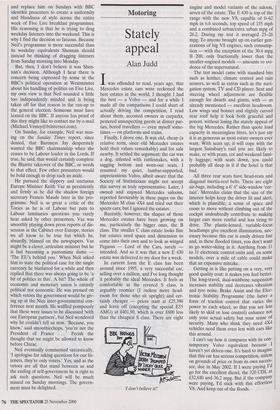Motoring
Stately appeal
Alan Judd
Iwas offended to read, years ago, that Mercedes estate cars were reckoned the best estates in the world. I thought I had the best — a Volvo — and for a while I made all the comparisons I could short of actually driving the competition, I read about them, accosted owners in carparks, pestered unsuspecting guests at dinner par- ties, bored travellers — even myself some- times — on platforms and trains.
Finally, I drove one. It was old, cheap (a relative term, since old Mercedes estates hold their values remarkably) and for sale nearby. It settled the argument: the car was a dog, infested with rattlesnakes, with a sagging bottom and worn-out seats. I resumed my quiet, lumbar-supported, unpretentious Volvo, albeit aware that the Society of Statisticians might not accept this survey as truly representative. Later, I owned and enjoyed Mercedes saloons, reported favourably in these pages on the Mercedes M class 4X4 and tried out their sports cars; but I ignored the estates.
Recently, however, the shapes of those Mercedes estates have been growing on me, particularly the bigger ones, the B class. The smaller C class estate looks fine but estates need space and dimension to come into their own and to look as winged Pegasus — Lord of the Cars, surely intended. And so it was that a new E 430 estate was delivered to my door for a week.
In current form the E class has been around since 1995, a very successful car, selling over a million, and I've long thought it probably the ideal Mercedes. It feels as comfortable as the revered S class, is arguably roomier (I reckon more head- room for those who sit upright) and cer- tainly cheaper — prices start at £25,390 and leave off (excepting the special E55 AMG) at £401,90, which is over £600 less than the cheapest S class. There are eight `I don't believe it!' engine and model variants of the saloon, seven of the estate. The E 430 is top of the range with the new V8, capable of 0-62 mph in 6.6 seconds, top speed of 155 mph and a combined urban/extra urban mpg of 26.2. During my test it averaged 25-26 mpg. To anyone brought up on earlier gen- erations of big V8 engines, such consump- tion — with the exception of the 30.4 mpg B 200, only fractionally lower than the smaller-engined models — amounts to evi- dence of the supernatural.
The test model came with standard bits such as leather, climate control and rain sensors, as well as extras such as the navi- gation system, TV and CD player. Seat and steering wheel adjustment are flexible enough for dwarfs and giants, with — as already mentioned — excellent headroom. Low wings and bonnet and slightly curved rear roof help it look both graceful and potent, without losing the stately appeal of the big Mercedes. Rather than quote load capacity in meaningless litres, let's just say it is as generous as most estate owners ever want. With seats up, it will cope with the largest Sainsbury's raid you are likely to make, or with pram, cot and weekend fami- ly luggage; with seats down, you could probably all sleep in it if the hotel is that bad.
All three rear seats have head-rests and diagonal inertia-reel belts. There are eight air-bags, including a 6' 6" side-window 'cur- tain'. Mercedes claim that the size of the interior helps keep the driver fit and alert, which is plausible; a sense of space and room to move without climbing out of the cockpit undoubtedly contribute to making larger cars more restful and less tiring to drive. The plastic-lensed, variable-focus headlamps give excellent illumination, nec- essary because this car is easily driven fast and, in these flooded times, you don't want to go water-skiing in it. Anything from 11 to 31 electronic control units and, on some models, over a mile of cable could make that an expensive mistake.
Getting in is like putting on a very, very good quality coat: it makes you feel better. The long-travel, dual-wishbone suspension increases stability and decreases vibration and tyre noise. Brake Assist and the Elec- tronic Stability Programme (the latter a form of traction control that varies the power to each wheel, so that you are less likely to skid or lose control) enhance not only your actual safety but your sense of security. Many who think they need 4X4 vehicles need them even less with cars like this around.
I can't say how it compares with its con- temporary Volvo equivalent because I haven't yet driven one. It's hard to imagine that this car has serious competition, unless on grounds of price or from its own succes- sor, due in May 2002. If 1 were paying I'd go for the excellent diesel, the 320 CDI, at £32,840 and 36.2 mpg. But if the companY were paying, I'd stick with this effortless V8. And keep out of the floods.





























































































 Previous page
Previous page